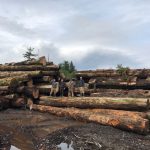
Before a tree is ready to be hewn and milled into soundboards, it has to mature until its growth lines reach a minimal density of roughly 10 lines per inch. In hardwood species, this maturation process takes roughly 95 years. In softwoods, it takes a minimum of 200 years. The trees we cut are, on average, 400 years old. Likewise, it’s imperative that we do everything in our power to employ sustainable logging practices as we harvest wood from these valuable, rare specimens. One way we can do this is by harvesting wood from downed trees rather than living organisms.
Around the perimeters of defunct logging operations, you can often find “blowdown patches” where trees have been knocked down by the heavy winds that blow uninterrupted across the deforested land. Rather than leaving these titans to rot in the forest, we can use their century-old wood to create brand new soundboards without having to fell another tree. Getting the downed tree from the forest to our shop, however, is no easy task.
Take the image on our front page, for example. Getting that Sitka Spruce out of the forest required logistical considerations on par with the invasion of Normandy. First, we established a staging area on a nearby island that could accommodate two cargo helicopters. Then, we cut the tree into sections and built a raft to transport the pieces across a river and onto the island. From there, our two hired helicopter pilots carried the tree sections back to our shop.
Blowdown patches aren’t the only source of salvaged wood we look to for our soundboards. In some cases, we’re able to reclaim the wood from old log bridges and log floats as well. The photo above shows a salvage operation from a 60 foot wide log float composed of fourteen logs, each of which is 80 feet long. The individual log highlighted in the picture may yield a total of only about ten guitar tops. The rest of the log is likely too worm-damaged and rotten to be salvageable.
Because the yield from salvaged wood sources is far lower than that of clearcutting operations, the work is far more labor intensive and expensive. In spite of this, we continue to compete directly with large factory milling and clearcutting operations. Once an old-growth forest is clearcut, it will take at least 1000 years to recover completely.
At Alaska Specialty Woods, we believe that it’s worth enduring all the added pain and consternation associated with obtaining salvaged materials if it means we can protect these old-growth forests. With the exception of our bearclaw figured soundboards, all of our soundboards are created from salvaged materials.
Check our complete products page here, and see what we’ve been able to make with salvaged wood.
All of the soundboards found on AlaskaWoods.com are sustainably harvested from old-growth timber, we call them EarthTone Soundboards™. Learn more about what makes EarthTone Soundboards™ the finest in the world.
Copyright © 2023 Alaska Woods • 855-425-9663